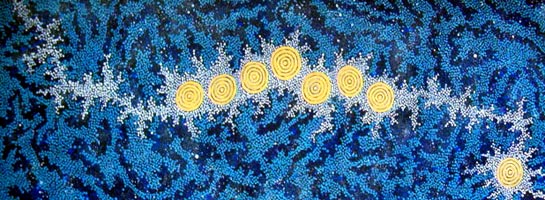
IAU Symposium 242
Astrophysical masers and their environments
Alice Springs, 12 to 16 March 2007

© Tourism NT
Science Rationale
Astrophysical masers are both a fascinating phenomenon and a powerful tool for probing a wide range of different astrophysical environments. Following the initial discovery of ‘mysterium’ in the early 1960s, later identified as maser emission from the OH molecule, maser emission has been identified from many different molecules. Strong emission is detected at centimeter and millimeter wavelengths from OH, H2O, SiO and CH3OH molecules, with weaker emission from higher frequency transitions of these molecules and from other molecules such as CH, NH3 and CHOH.
Considerable progress was made during the 1990s in understanding and observing the complexities of the regions in which the masers are found. Masers are observed in the interstellar medium and star-formation regions, in the expanding winds from evolved stars, in the compressed shells of supernovae remnants, in comets and in or near the nuclei of galaxies. Systematic surveys have led to the detections of many hundreds of maser sources. Much progress has been made in understanding the pumping mechanisms of the different maser transitions. For some masers, such as OH masers and the ‘class II’ methanol masers (associated with ultra-compact HII regions), the population inversion requires radiative pumping from far-infrared photons and the masers are closely associated with cool dust – either from molecular clouds, or in the atmospheres of evolved stars. Other masers, including ‘class I’ methanol masers (not associated with ultra-compact HII regions) are likely to be collisionally pumped.
In the interstellar medium, OH, H2O and methanol masers are associated with ultra-compact HII regions, embedded infrared objects, hot molecular cores, Herbig-Haro objects and outflows from young stellar objects. High resolution observations from long baseline arrays, such as MERLIN in the UK, the Very Long Baseline Array in the US, and the European VLBI Network (EVN), have shown highly complex and varied structures with spherical expansion, bipolar outflows, disks and rings, bow-shocks and infall. By combining the spatial imaging capabilities with high velocity resolution dynamical information it is possible to image and interpret the three-dimensional distribution of masers in great detail, and in some cases to obtain proper motions and accurate distance estimates.
Since the 1980s masers have been used to study the outflowing winds from evolved stars. These winds play a critical role in stellar evolution as they return more than 40 per cent of a star’s mass back to the interstellar medium for recycling. The classical winds of the so-called OH/IR stars have a spherical structure and the masers probe the winds at different radii providing information on the densities, temperatures and mass-loss rates in the outflows. These compact and bright sources also provide ideal samples for studying stellar dynamics and Galactic structure. Much more recently, masers have been discovered in post-AGB stars. These objects are in a very short-lived evolutionary stage during which the stars evolve from the AGB to become planetary nebulae. The maser and infrared properties can be used to identify post-AGB stars. Planetary nebulae can reveal many different forms. While some appear circular, others have the shapes of butterfly wings, or show bipolar or elliptical structures. The onset of these structures appears to begin in the post-AGB phase and masers provide an excellent means for studying the rapid changes in wind morphologies and dynamics. Of particular interest has been the recent detection of high-velocity water jets in several post-AGB stars. Such jets may indicate a very early stage in the transition away from the AGB when a hot fast wind from the central star switches on.
Magnetic fields play a critical role in star birth and star death. Masers provide an excellent means of studying the magnetic fields in the dense regions where they are located. For OH masers, strong polarization is observed from the Zeeman effect with line-splitting that is often significantly larger than the line width. Magnetic fields of several milliGauss are typically measured in both star-formation regions and stellar winds. Good theoretical and observational progress has been made in the last few years in understanding the polarization properties of other maser transitions, in particular from H2O and SiO molecules, where the Zeeman effect is much weaker. Recent polarization observations of the OH maser emission from post-AGB stars have provided the first unambiguous detections of the pi transitions.
Some of the most exciting results in recent years have come from maser observations of other galaxies. Following the discovery of H2O maser emission in an accretion disk within one parsec of a super-massive black hole in the nucleus of the spiral galaxy NGC 4528, H2O masers have now been detected from the nuclear regions of approximately 70 galaxies. In most cases, H2O masers are associated with central accretion disks, similar to NGC 4528. However recent observations have also detected H2O masers which appear to originate from an interaction between a nuclear jet and a nearby molecular cloud. In a recent observation, an H2O maser, with a luminosity of 23,000 L was detected at a redshift of 0.66. In megamaser galaxies, the OH masers are associated with starburst or other nuclear activity within the central ~100 parsec of infrared-luminous galaxies. These masers probe the central interstellar medium of starburst and active galaxies. A recent model (for the megamaser galaxy IIIZw35), shows that the masers may be highly clumped and located in a thin circumnuclear rotating ring. The study of extragalactic masers has recently included the first detections of millimeter maser emission from external galaxies.
This meeting will be the third international symposium on astronomical masers. The first was held in March 1992 in Virigini US (Lecture Notes in Physics: Astrophysical Masers, 1993, eds, Clegg & Nedoluha, Springer-Verlag, Berlin). The developments of the 1990s were discussed at the second symposium which was held as an IAU Symposium in March 2001, in Managratiba, Brazil (IAU 206: Cosmic Masers: From Protostars to Black Holes, eds Migenes & Reid). Both meetings were attended by over 100 astronomers from approximately 20 countries.
It is now time to hold a third symposium on Astrophysical masers to discuss the many developments since the 2001 meeting. Masers originate in a variety of different environments and are associated with a wide variety of phenomena but they are all linked by common physics. The majority of masers are closely connected with dust or the physics of shock-waves; in addition, observations over the past few years have demonstrated that magnetic fields are ubiquitous in regions of strong maser emission. Therefore, by bringing together astronomers who observe masers and theoreticians who try to understand the physics of the masers and their environments we hope to address a broad range of astrophysical problems. This meeting will bring the international community together to review the observational and theoretical progress over the last six years; show recent results from new facilities such as the sub-millimeter array (SMA); and look ahead to what may be possible with future facilities such as the Atacama Large Millimeter Array (ALMA), and the international Square Kilometre Array (SKA).
